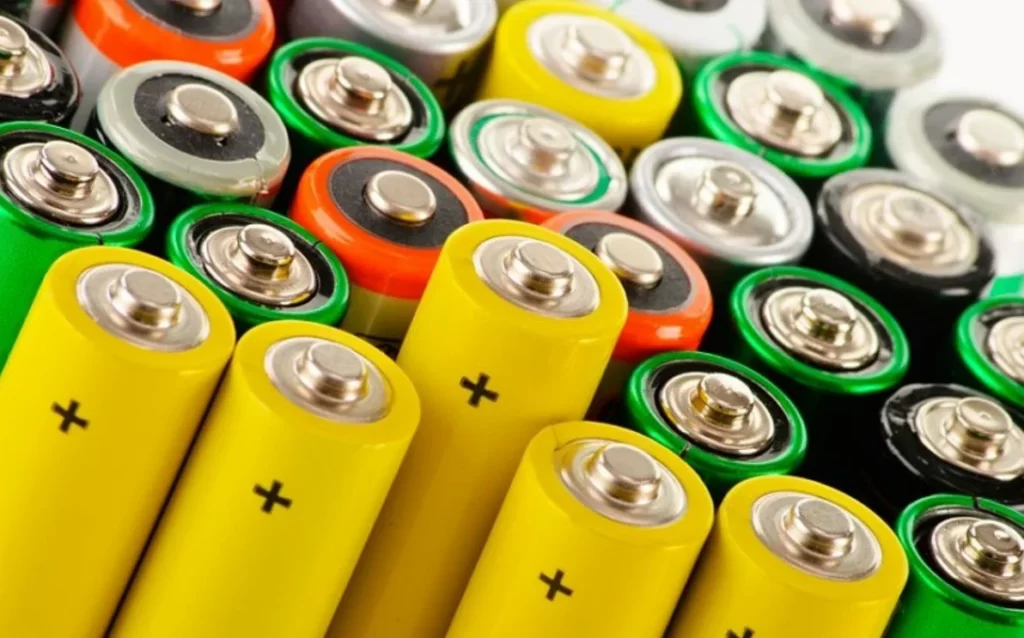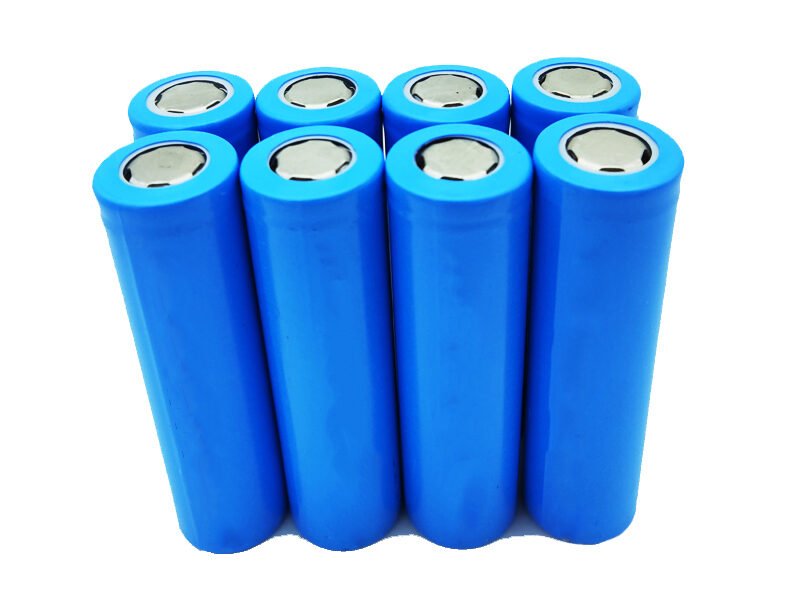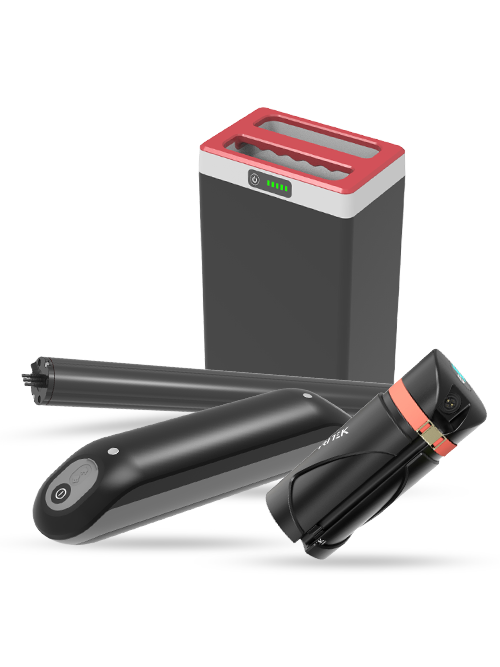There are a few different battery technologies on the market that are suitable for electric bikes. In this blog post, we will compare and contrast the most popular electric bike battery types: lithium-ion LiFePO4, NCM, and NCA batteries, lead-acid, nickel-cadmium, and nickel-metal hydride.
We will discuss the pros and cons of each technology, as well as their suitability for e-bikes. By the end of this post, you will have a good understanding of which electric bike battery technology is best for your needs!

Electric bike battery types
Before you can choose the optimal battery for your e-bike, you must first understand the terminology used to describe e-bike batteries.
- Voltage (V)
- Capacity – Ampere per hour (Ah)
- Discharge rate (C)
Voltage (V)
Voltage is used to describe the rate at which electrons move, an increased voltage means more speed. It is also called volts. The ideal rating for an electric bike battery is 36-48V.
Capacity – Ampere per hour (Ah)
The quantity of energy that can be in a battery cell is known as its capacity. It is the most vital feature of any battery, and the unit of measurement is ampere-hour (Ah). The Ampere per hour is an electrical charge unit with dimensions of electric current versus time. It indicates the capacity of the battery. A 15Ah battery can discharge 1.5A constantly for ten (10) hours or 15A continuously for an hour.
Discharge rate (C)
The max discharge rate of a cell is the highest current that the cell can be safely discharged at. However, The max discharge rate of a pack must be lower than a cell discharge.
For example, a battery pack with 10S1P. The maximum discharge rate of the cell is 10A. Then, the maximum discharge rate of a pack must be lower than 10A.
Learn more about important part components of an e-bike battery
Lithium-ion batteries
Lithium-ion batteries for e-bikes are becoming more popular as technology improves. Li-ion batteries do not require regular maintenance. Lithium-ion batteries include lithium manganese batteries, lithium-ion polymer batteries, NCA, NCM, LiFePO4, etc.
Lithium-ion batteries offer several advantages, but they also have some drawbacks that you should be aware of before making your decision. Weigh up the pros and cons to decide whether a lithium-ion battery NCM and NCA is right for you.
Advantages of lithium-ion batteries NCM and NCA
Lithium-ion batteries NCM and NCA are one of the most popular types of batteries for e-bikes.
1. High capacity
Lithium-ion batteries have a high capacity, meaning that they can store more energy than other types of batteries. This makes them suitable for applications where long run times are required.
2. Weight and size
Lithium-ion batteries are also the lightest weight option, making them ideal for use in LEVs. Lithium-ion batteries are also small in size and mass, making them easy to integrate into a wide range of LEVs.
3. No “memory” effect
Li-ion batteries also do not have a “memory” effect, meaning that they do not need to be regularly discharged to maintain their capacity.
4. Low self-discharge
Li-ion batteries also have a low self-discharge rate, meaning that they lose less capacity when not in use.
5. Possibility of fast charging
Li-ion batteries can also be fast-charged, meaning that you can get back on the road more quickly after a long journey.
6. Lots of charge/discharge cycles
Lithium-ion batteries also have a long lifespan and can be charged and discharged many times without losing their capacity. Additionally, they are not damaged by being discharged and recharged frequently, as some other types of batteries are.
7. High energy density
Li-ion batteries have a high energy density, meaning that they can store a lot of energy in a small space. This makes them ideal for applications where weight and size are critical, such as in LEVs.
Disadvantages of lithium-ion battery
1. High price of lithium batteries
The main disadvantage of lithium-ion batteries is their cost. They are currently much more expensive than other types of batteries.
2. Sensitive to low temperatures
Lithium batteries can also be damaged by extreme temperatures, so they may not be suitable for use in very cold climates.

Advantages of lithium-ion batteries LiFePO4
LiFePO4 batteries offer several advantages over other e-bike battery technologies, making them an attractive option for LEVs.
Advantages of LiFePO4 batteries
1. Low price
LiFePO4 batteries are not expensive as other li-ion batteries.
2. No “memory” effect
LiFePO4 batteries do not have a “memory” effect, meaning that they do not need to be regularly discharged to maintain their capacity.
3. Low self-discharge
LiFePO4 batteries have a low self-discharge rate, meaning that they retain their charge for longer than other types of batteries.
4. Lots of charge/discharge cycles
LiFePO4 batteries have a high number of charge/discharge cycles, meaning that they will last for a long time before needing to be replaced. More than 2500 cycles for LiFePO4 and around 500-1000 cycles for NCM, and NCA.
5. Possibility of fast charging
LiFePO4 batteries can be charged using a fast-charging method, which can be useful for applications where quick charging is required.
6. Safety
LiFePO4 is safe because they use organic materials instead of the flammable liquids found in other types of batteries. This makes them less likely to catch fire or explode if there is an accident.
Disadvantages of lithium iron phosphate batteries
1. Low energy density
LiFePO4 batteries have a low energy density, meaning that they cannot store as much energy in a given space. This makes them less suitable for applications where weight and size are critical, such as in LEVs.
2. Heavier than other li-Ion
LiFePO4 batteries are also heavier than other lithium-ion batteries, making them less suitable for applications where weight is a critical factor.

Despite the disadvantages of lithium-ion battery technology, it is still the most popular choice for light electric vehicles such as e-bikes and scooters. This is because the advantages of lithium-ion battery technology outweigh the disadvantages.
Discover more about e-bike trend in 2022 — in-tube batteries
If you are considering an e-bike, lithium-ion batteries are worth considering.
Lead-acid batteries
Lead-acid batteries are one of the types of all the types of electric bike battery types available. They are affordable but they are also heavy and not as energy-dense as other options. Lead-acid batteries are not as environmentally friendly as others, but they can be recycled.
Advantages of lead-acid batteries
Lead-acid batteries have some advantages over other e-bike batteries.
1. Stability
Lead-acid batteries are very rugged and can withstand a fair amount of abuse.
2. Low cost
Lead-acid batteries are the cheapest compared to other electric bike battery technologies.
3. Well-suited for high-discharge applications
Lead-acid batteries are well-suited for high-discharge applications such as electric cars.
4. High current density
Lead-acid batteries have a high current density, which means they can provide a lot of power for their size.
5. Work temperature range
Lead-acid batteries have a wide temperature range and can operate in both hot and cold climates.
Disadvantages of lead-acid batteries
Lead-acid batteries also have some disadvantages that should be considered.
1. Heavy battery
Lead-acid batteries are one of the heaviest types of batteries, which can negatively impact the range and performance of LEVs.
2. Low energy density
Lead-acid batteries are also not as energy-dense as lithium-ion options, lead-acid batteries also have a relatively low cost per kWh.
3. Deep discharge can damage
Lead-acid batteries cannot be discharged below 50% without damaging the cells.
4. High self-discharge
Lead-acid batteries also have a high self-discharge rate of about 20% per month.
Nickel-cadmium batteries
Nickel-cadmium batteries are the type of battery used in small LEVs, such as scooters. They are rugged and can operate in a wide range of temperatures, making them good for use in outdoor applications. However, they require special disposal procedures due to their toxicity.
Advantages of nickel-cadmium batteries
1. Low cost
Nickel-cadmium batteries are one of the most affordable types of electric bike batteries on the market.
2. High power density
Nickel-cadmium batteries have a high-power density, which makes them good for use in small LEVs.
3. Work in a wide temperature range
Nickel-cadmium batteries can operate in a wide range of temperatures, making them suitable for outdoor applications.
4. Possibility of fast charging
Nickel-cadmium batteries can be fast-charged, meaning that they can be recharged in a shorter time than other electric bike battery technologies.
Disadvantages of nickel-cadmium batteries
Nickel-cadmium batteries have several disadvantages that make them unsuitable for many applications, including e-bikes.
1. High degree of self-discharge
Nickel-cadmium batteries have a high self-discharge rate, meaning that they lose their charge very quickly when not in use. This can be a problem for applications where the battery will not be used for extended periods of time, such as in light electric vehicles.
2. “Memory” effect
Nickel-cadmium batteries suffer from the “memory” effect, which means that they lose capacity if they are not regularly fully discharged.
3. Large size
Nickel-cadmium batteries are usually much larger and heavier than other battery technologies, making them unsuitable for applications where weight and size are important considerations.
4. Toxicity if disposed of incorrectly
Nickel-cadmium batteries contain poisonous heavy metals such as cadmium and mercury, which can pose environmental hazards if the batteries are not disposed of properly.
5. Low energy density
Nickel-cadmium batteries also have a low energy density compared to other electric bike battery technologies.
In conclusion, nickel-cadmium batteries are not the best choice for powering e-bikes.
Nickel-metal-hydride batteries
Nickel-metal-hydride batteries are another rechargeable electric bike battery types that have been used in LEVs. These batteries have a higher energy density than lead-acid batteries, which means that they can store more energy per unit of weight. However, they also tend to be more expensive.
Nickel-metal-hydride batteries are not as widely used in LEVs, but they offer some advantages in terms of performance and cost.
Advantages of nickel-metal-hydride batteries
1. Low cost
Nickel-metal-hydride batteries are one of the most affordable types of batteries on the market. This makes them a good choice for applications where cost is an important consideration.
2. High capacity
Nickel-metal-hydride batteries have a high capacity, meaning that they can store more energy than other types of batteries. This makes them suitable for applications where long run times are required.
3. Low toxicity
NiMH batteries are that they do not contain heavy metals, such as lead or cadmium, which are harmful to the environment.
4. Work in a wide temperature range
NiMH batteries can operate in a wide range of temperatures, making them suitable for use in a variety of climates.
Disadvantages of nickel-metal-hydride batteries
Nickel-metal-hydride batteries have several disadvantages when compared to other battery technologies.
1. High degree of self-discharge
NiMH batteries have a high self-discharge rate, meaning that they lose their charge very quickly when not in use.
2. Slow charging
NiMH batteries take a long time to charge, which can be a problem for applications where quick charging is required.
3. Few charge/discharge cycles
NiMH batteries have a limited number of charge/discharge cycles, meaning that they will eventually need to be replaced.
4. Mild “memory” effect
NiMH batteries also have a milder “memory” effect than nickel-cadmium batteries, meaning that they need to be regularly discharged about every two months to maintain their capacity. Li-ion batteries don’t have a ”memory” effect.
5. Not as energy-dense as li-ion
NiMH is not as energy-dense as lithium-ion batteries, meaning that they cannot store as much energy in a given space. This makes them less suitable for applications where weight and size are critical, such as in e-bikes.
Electric bike battery types conclusion
No matter which type of battery you choose, it is important to make sure that it is compatible with your e-bike. Be sure to consult with a qualified technician to find the best option for you. Our Tritek specialists are eager to help you with your battery needs.
Tritek is a professional OEM/ODM of e-bike batteries, which is with more than 12 years of experience. We design and produce the complete intelligent lithium-ion battery pack for light electric vehicles, including the smart BMS and battery.
This blog post was brought to you by the team from the Tritek company. If you’re interested in learning more about us, please feel free to contact us. We hope this article was helpful. Thanks for reading!
Read more:



